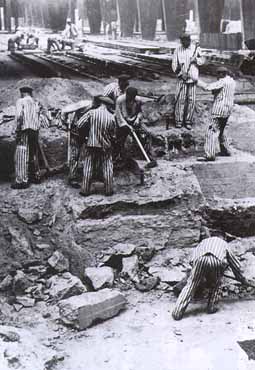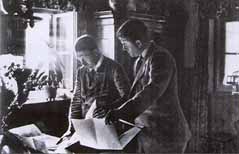The World's Largest Brick Factory Adolf Hitler had always wanted to become an architect, but he failed the entrance exam for architectural school in Vienna. As the Chancellor of Germany, he had a grandiose plan for the remodeling of the city of Berlin into the capital of the future Grand German Empire. The dream of Pan-Germanism, or the unification of all ethnic Germans into one country, had been discussed since the 1880ies. The movement was even stronger in Hitler's native Austria than in Germany. When Hitler was just a school boy, the proponents of Pan-Germanism were displaying the German flag and singing the German national anthem. At the same time, the Zionists were working toward having their own country in Palestine. The unification of all the German people was the last thing that France and Great Britain, the great powers of Europe at that time, wanted to see happen. After World War I, the Versailles Peace Treaty specifically forbade the merger of Germany and Austria into one country. This was just one of the many rules of the Treaty that Hitler broke when he marched into Austria in March 1938 and declared the Anschluss of Germany and Austria, which was the start of the Greater German Reich. Hitler had planned a world exhibition in 1950, at which time the city of Berlin would be renamed Germania. By that time, Hitler had envisioned that all the Volkdeutsch (ethnic Germans) would be living together in one united country, which would dominate the world as the only super power. Authority for this building project came from the "Legislation for the reconstruction of German cities," which dated from October 4, 1937. Albert Speer, Hitler's official architect since 1933, was given the job of planning the construction project for Berlin, although Hitler designed some of the buildings himself.  The proposed design for Berlin included the building of a magnificent avenue, 7 kilometers long, which would run north and south, and would intersect with the broad Unter den Linden street at the famous Brandenburg gate. The street was to end at the Grand Hall, planned to be the largest building in the world. It was to be 290 meters high and 315 meters long with a seating capacity of 150,000 to 180,000 people. Hitler designed this building himself with a little help from Albert Speer. All the buildings in this project were planned to be classic buildings along the lines of those in ancient Greece and Rome. To provide building materials for this project, beginning in the summer of 1938, the prisoners at the Sachsenhausen concentration camp were used as forced labor in the construction of the world's largest brickworks just outside the camp, near the Lehnitz lock on the Hohenzollern canal. When World War II started in 1939, Hitler's building plans had to be put on hold, but after the victory over France in 1940, the plans resumed.  The prisoners who were assigned to the brickworks (Klinkerwerk) were called the "punishment commando." The workers had to march to and from the camp to the brickworks each day. In 1941 the Klinker punishment commando was given the status of a satellite camp or sub-camp of the Sachsenhausen concentration camp. Barracks were built on the southeast side of the plant to house the workers. According to an Information Leaflet about the Klinkerwerk, the satellite camp was used for ... the deliberate annihilation of certain prisoners groups. From July to September 1942, the systematically planned murders of some 180 to 200 homosexual prisoners were carried out in the Klinker satellite camp. As the closest concentration camp to Berlin, Sachsenhausen had more homosexual prisoners than any of the other camps. A total of approximately 10,000 homosexuals were sent to all the Nazi concentration camps combined during the 12 years of the Third Reich. In an era when homosexuals were still in the closet in all the countries of the world, Berlin was a mecca for gays. The movie Cabaret depicts the gay scene in Berlin before the Nazis came to power. It was based on a book entitled "Goodbye to Berlin" by Christopher Isherwood, who lived an openly gay lifestyle in the capital city. Only male homosexuals who broke the German law by flaunting their lifestyle in public were arrested. After their second arrest and prison term, they were sent to the concentration camps; no lesbians were ever sent to the camps, solely for being lesbians. Some of the young men, who were sent to Sachsenhausen after they had been imprisoned for public homosexual activity, were actually Strichjunge, or male prostitutes, from Berlin. According to the memoirs of Rudolf Höss: The strict camp life and the hard work quickly reeducated this type. Most of them worked very hard and took great care not to get into trouble so that they could be released as soon as possible. They also avoided associating with those afflicted with this depravity and wanted to make it known that they had nothing to do with homosexuals. In this way countless rehabilitated young men could be released without having a relapse. In 1943 the brick factory was partly converted into an armament factory where hand grenades were produced. On April 10, 1945, an Allied bombing raid destroyed the armament factory and the brickworks. About 200 prisoners of the concentration camp lost their lives in the raid. Tour of Sachsenhausen Memorial SiteTable of ContentsHome |